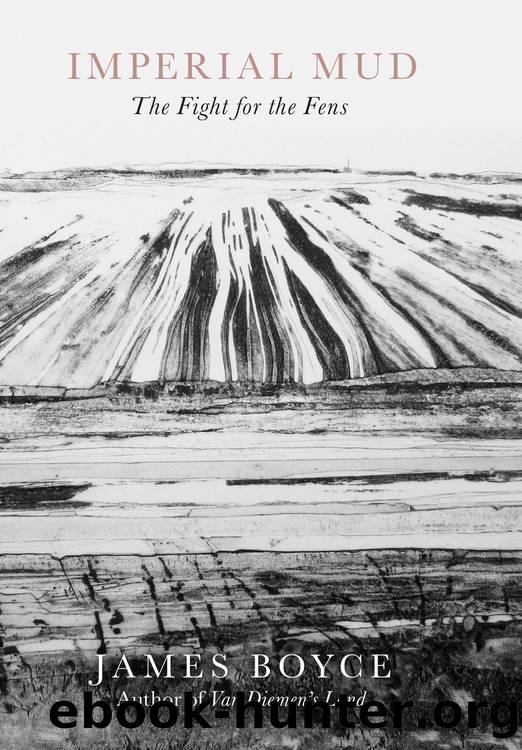Imperial Mud by James Boyce

Author:James Boyce
Language: eng
Format: epub
Publisher: Icon Books Ltd
Published: 2020-08-15T00:00:00+00:00
CHAPTER 10
The Foundation of Fennish Freedom
In 1700 it seemed that the culture and community life based around the common marsh had been permanently protected outside the Great Level. The successful resistance of the Fennish was based on their capacity to meet basic needs without succumbing to state, employer or landlord power. Their ability to obtain food, clothing, shelter and income directly from the natural environment meant that the people of the Fens did not have to submit in order to survive.
Historians disagree on how much difference the resources of the common made to ordinary English people by the eighteenth century. The evidence suggests that large numbers of commoners were dependent on wages long before formal enclosure took place (which could be a piecemeal process over generations). However, this debate does not extend to the Fens, where there is no dispute concerning the significance of the common or the level of disruption associated with drainage and enclosure.1 In Donington near Boston in 1767, it was recorded that 100 per cent of labourers were keeping cows; at Shouldham in Norfolk, 56 per cent of labourers owned cattle as late as 1794. Access to a single cow could provide a return of five to six shillings per week in the late eighteenth century, roughly equivalent to an agricultural labourer’s wage.2
The agriculturalist Arthur Young recognised that the commons of Lincolnshire ensured that ‘land, gardens, cows, and pigs, are so general in the hands of the poor’, meaning that ‘poor-rates are low; upon an average of the county, they do not amount to one third of what is paid in Suffolk’.3
The freedom conferred by the common remained particularly important for women (whose right to ‘reasonable estovers* of commons’ was even acknowledged in the Magna Carta). The cow-owning widow of ‘Jack and the Beanstalk’, dependent on common pastures for her livelihood, was based on historical reality (as were the stories of dispossessed village women surviving in large towns in any way they could).4
The economic independence of the Fennish was a serious problem for landowners, tenant farmers and drainage engineers seeking not only submission to their enclosure plans but a subservient labour force. The commons were rightly recognised to promote ‘indiscipline and indolence among the workers’ because they meant that people’s survival did not depend on them accepting the discipline of waged work.5 The reason that immigrants had to be employed on engineering schemes and enclosed farms was primarily because the locals had an attractive alternative available to them.6 This competition also meant that higher wages had to be paid. Young observed that labour costs in the Lincolnshire fens were ‘probably higher than in any other county in the kingdom’.7
The freedom of the commons was grounded in not just the quantity but the range of resources available. James C. Scott has described wetlands as places of ‘fugitive diversity’ because the variety of birds, fish, and animals returning at predictable times allowed ordinary people to access what they needed without the rigours and risks of conventional farming.8 Unlike
Download
This site does not store any files on its server. We only index and link to content provided by other sites. Please contact the content providers to delete copyright contents if any and email us, we'll remove relevant links or contents immediately.
| Africa | Americas |
| Arctic & Antarctica | Asia |
| Australia & Oceania | Europe |
| Middle East | Russia |
| United States | World |
| Ancient Civilizations | Military |
| Historical Study & Educational Resources |
Magic and Divination in Early Islam by Emilie Savage-Smith;(1500)
Ambition and Desire: The Dangerous Life of Josephine Bonaparte by Kate Williams(1344)
Bohemians, Bootleggers, Flappers, and Swells: The Best of Early Vanity Fair by Bohemians Bootleggers Flappers & Swells- The Best of Early Vanity Fair (epub)(1343)
Papillon by Henry Charrière(1310)
Twelve Caesars by Mary Beard(1256)
Operation Vengeance: The Astonishing Aerial Ambush That Changed World War II by Dan Hampton(1136)
What Really Happened: The Death of Hitler by Robert J. Hutchinson(1128)
London in the Twentieth Century by Jerry White(1113)
Time of the Magicians by Wolfram Eilenberger(1089)
The Japanese by Christopher Harding(1086)
Twilight of the Gods by Ian W. Toll(1084)
Lenin: A Biography by Robert Service(1045)
The Devil You Know by Charles M. Blow(985)
A Social History of the Media by Peter Burke & Peter Burke(936)
Freemasons for Dummies by Hodapp Christopher;(922)
Napolean Hill Collection by Napoleon Hill(902)
Henry III by David Carpenter;(891)
The Churchill Complex by Ian Buruma(881)
The Rise and Triumph of the Modern Self by Unknown(879)
